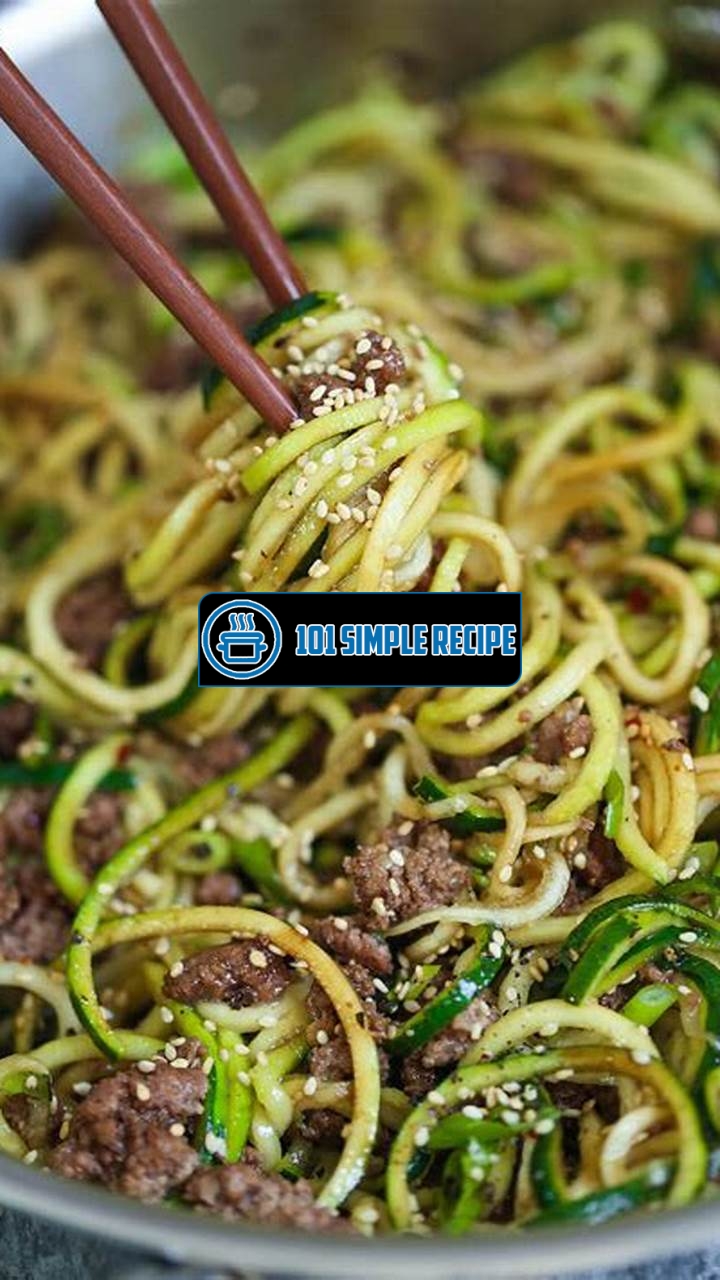If you’re craving a delicious and healthy alternative to traditional pasta, look no further than these delectable Korean Zucchini Noodles! Bursting with flavor and offering a unique twist on a classic dish, these zoodles are set to become your new favorite go-to meal. Made from spiralized zucchini, these noodles are not only low in carbs and calories but also packed with nutrients. The combination of fresh ingredients and vibrant Korean flavors creates a dish that is both satisfying and bursting with umami goodness. Whether you’re a vegetarian, a health-conscious foodie, or simply looking to add some variety to your weekly menu, these Korean Zucchini Noodles are a delightful choice you won’t be able to resist.

The Origins of Korean Zucchini Noodles
Discover the history and cultural significance of Korean zucchini noodles, also known as “hobak julienne” or “hobak-myeon.”
Korean cuisine is renowned for its diverse flavors and healthy ingredients. One dish that has gained popularity in recent years is Korean zucchini noodles. But where did this delicious dish originate from, and what is its cultural significance? Let’s dive into the origins of Korean zucchini noodles to find out!
The Traditional Korean Diet
The traditional Korean diet dates back centuries and is rooted in a balanced approach to eating. Staples such as rice, vegetables, fermented foods, and lean proteins form the foundation of Korean meals. This emphasis on fresh, whole ingredients contributes to the overall health benefits of Korean cuisine.
In the past, Koreans primarily consumed noodles made from various grains, including wheat and sweet potato starch. However, as culinary preferences evolved, so did the desire for lighter and healthier alternatives. This led to the rise of Korean zucchini noodles, which are not only packed with flavor but also offer a nutritious twist to traditional pasta dishes.
Zucchini as a Staple Ingredient
Zucchini, also known as courgette, is a summer squash that originated in the Americas but became popular in Korean cuisine over time. Its mild flavor and versatile texture make it an ideal ingredient for a wide range of dishes. From stir-fries to soups, zucchini adds a refreshing touch while absorbing the flavors of the other ingredients.
In Korean cooking, zucchini is often used as a base for various vegetable dishes. It is sliced into thin strips or julienned to create the iconic zucchini noodles. These noodles are not only a healthy and delicious alternative to traditional pasta but also a visually appealing addition to any meal.
The Rise of Zucchini Noodles
The popularity of zucchini noodles has surged in recent years, not only in Korea but also across the globe. This can be attributed to the growing emphasis on health-conscious eating and the rise of low-carb and gluten-free diets. Zucchini noodles provide a satisfying substitute for wheat-based pasta without sacrificing taste or texture.
With the availability of spiralizers and other kitchen tools, it has become easier than ever to transform zucchini into noodles at home. This has empowered home cooks to experiment with Korean zucchini noodles and incorporate them into a variety of dishes.
Furthermore, the rise of Korean cuisine has also contributed to the increasing popularity of zucchini noodles. As more people discover the unique flavors and health benefits of Korean food, the demand for Korean-inspired dishes, including zucchini noodles, continues to grow.
In conclusion, Korean zucchini noodles have a rich history and cultural significance within the Korean culinary landscape. From their origins in traditional Korean cuisine to their rise as a popular alternative to traditional pasta, these flavorful noodles have captured the attention of food enthusiasts worldwide. Whether you’re looking for a healthier pasta option or simply want to explore new flavors, Korean zucchini noodles are a delicious and nutritious choice.
Nutritional Benefits of Korean Zucchini Noodles
When it comes to healthy eating, finding delicious alternatives to traditional pasta can be a game-changer. Korean zucchini noodles offer a flavorful twist that not only satisfies your taste buds but also provides numerous health benefits. Incorporating these noodles into your diet can be a smart way to boost your nutrition while enjoying a tasty and satisfying meal.
Low-Calorie and Low-Carb Option
If you’re watching your calorie intake or following a low-carb diet, Korean zucchini noodles can be your new best friend. These noodles are incredibly low in calories and carbs, making them an ideal choice for weight-conscious individuals or those looking to maintain a healthy lifestyle. By replacing regular pasta with zucchini noodles, you can cut back on your calorie and carb intake while still enjoying a filling meal.
Zucchini noodles are an excellent substitute for traditional pasta when you want to shed some pounds or maintain a healthy weight.
Rich in Vitamins and Minerals
Another fantastic benefit of Korean zucchini noodles is their impressive nutrient content. These noodles are packed with essential vitamins and minerals that are vital for your overall well-being. Zucchini is a great source of vitamin C, which helps strengthen your immune system and fights off harmful free radicals. It also contains vitamin A, which promotes healthy vision and supports proper cell growth.
By incorporating Korean zucchini noodles into your diet, you can ensure you’re getting a good dose of important vitamins that your body needs to function optimally.
A Good Source of Dietary Fiber
Dietary fiber plays a crucial role in maintaining a healthy digestive system and preventing various illnesses. Korean zucchini noodles are an excellent source of fiber, which can aid in digestion, prevent constipation, and promote a feeling of fullness. Adding these noodles to your meals can help you meet your daily fiber requirements and support a healthy gut.
Boost your fiber intake by including Korean zucchini noodles in your diet, and experience improved digestion and a satisfied stomach.
Overall, Korean zucchini noodles offer an array of nutritional benefits that make them an excellent addition to any diet. They are low in calories and carbs, rich in vitamins and minerals, and provide a good source of dietary fiber. By incorporating these flavorful noodles into your meals, you can enjoy a healthier twist on traditional pasta without sacrificing taste or nutrition. So why not give Korean zucchini noodles a try and take a step towards a more wholesome and enjoyable way of eating?
Preparing and Cooking Korean Zucchini Noodles
Learn step-by-step instructions on how to prepare and cook Korean zucchini noodles for a delicious meal.
Choosing the Right Zucchini
When it comes to making Korean zucchini noodles, it is essential to choose the right zucchini. Look for zucchinis that are firm, with a vibrant green color and smooth skin. Avoid zucchinis that are soft or have blemishes, as they may not hold up well during the cooking process. It is best to use medium-sized zucchinis for this dish as they are easier to spiralize and cook evenly.
⭐ Pro Tip: For added flavor and a visually appealing presentation, consider using a combination of green and yellow zucchinis.
Methods of Cutting and Slicing
Once you have selected the perfect zucchinis, the next step is to prepare them for spiralizing. Start by washing the zucchinis thoroughly under running water to remove any dirt or residue. Trim off both ends of the zucchinis using a sharp knife. This will create a flat surface that will make it easier to spiralize the zucchinis.
⭐ Pro Tip: If you prefer softer zucchini noodles, you can blanch them in boiling water for a minute before cooking them further.
Next, you will need a spiralizer to create the zucchini noodles. There are various types of spiralizers available in the market, ranging from handheld spiralizers to countertop spiralizers. Follow the instructions provided with your spiralizer to create long, noodle-like strands from the zucchinis.
Cooking Techniques and Seasonings
Now that you have prepared the zucchini noodles, it’s time to cook them to perfection. One popular cooking technique for Korean zucchini noodles is stir-frying. Heat a tablespoon of vegetable oil in a large skillet or wok over medium-high heat. Add the zucchini noodles to the skillet and cook for 2-3 minutes until they are slightly softened but still retain their crunch.
⭐ Pro Tip: To enhance the flavor of the zucchini noodles, you can add minced garlic and grated ginger to the skillet before cooking.
For seasoning, soy sauce is a staple ingredient in Korean cuisine. Add a few tablespoons of soy sauce to the skillet and toss the zucchini noodles to ensure they are well coated. You can also add a teaspoon of sesame oil for a nutty aroma and a sprinkle of red pepper flakes for a spicy kick.
⭐ Pro Tip: If you prefer a lighter seasoning, you can substitute soy sauce with tamari or coconut aminos.
Continue cooking the zucchini noodles for another 2-3 minutes, stirring them constantly to prevent sticking. The noodles should be tender but still have a slight bite.
⭐ Pro Tip: Avoid overcooking the zucchini noodles as they can become mushy and lose their texture.
Once cooked, remove the zucchini noodles from the heat and serve them immediately as a side dish or as the main course. They pair well with grilled meats, stir-fried vegetables, or can even be enjoyed on their own.
Preparing and cooking delicious Korean zucchini noodles is a simple and flavorful way to enjoy a twist on traditional pasta. By choosing the right zucchinis, mastering the art of cutting and slicing, and using the right cooking techniques and seasonings, you can create a mouthwatering dish that will impress your family and friends.
Craving something sweet? Try this simple and tasty cookie in a mug recipe. It’s the perfect treat for when you want something sweet but don’t feel like baking a whole batch of cookies.
Variations and Additions to Korean Zucchini Noodles
Discover unique twists and additions to the classic Korean zucchini noodle dish to enhance its flavor and appeal.
Spicy Korean Zucchini Noodles
If you’re a fan of spicy food, you’ll love the spicy variation of Korean zucchini noodles. To give these noodles a kick, add a generous amount of gochujang, a traditional Korean spicy condiment made from red chili peppers, fermented soybeans, and rice. The gochujang will infuse the noodles with a fiery heat and a distinctly Korean flavor. Top it off with some sliced green onions and a sprinkle of sesame seeds to add extra depth and texture to your spicy zucchini noodles. ️
To ensure that the spiciness is balanced, you can also add a squeeze of lemon or lime juice to brighten the flavors. The acidity of the citrus fruits helps to cut through the heat and adds a refreshing tanginess to the dish.
Zucchini Noodles with Korean BBQ Beef
For a heartier and more substantial meal, consider adding Korean BBQ beef to your zucchini noodles. Start by marinating thinly sliced beef ribs or beef bulgogi in a mixture of soy sauce, garlic, ginger, and sugar. Allow the meat to soak in the flavors for at least 30 minutes, or overnight for maximum taste.
Once marinated, grill the beef until it’s tender and juicy. Then, simply toss the grilled beef with your zucchini noodles and garnish with sesame seeds and chopped green onions. The combination of the savory, umami-rich beef and the light, refreshing zucchini noodles creates a delightful contrast of flavors and textures that will satisfy your hunger and tantalize your taste buds.
Creative Ingredient Substitutions
If you’re looking to put your own unique spin on Korean zucchini noodles, don’t be afraid to get creative with ingredient substitutions. For example, if you’re not a fan of zucchini or simply want to try something different, you can substitute the zucchini with other vegetables like carrots, cucumber, or daikon radish.
Additionally, you can experiment with different sauces and seasonings to customize the flavor profile of your noodles. Consider using tamari or coconut aminos instead of regular soy sauce for a gluten-free alternative. You can also try adding a dash of fish sauce or oyster sauce for a hint of umami. Don’t be afraid to mix and match ingredients to create a version of Korean zucchini noodles that suits your taste preferences and dietary restrictions.
Remember, the beauty of Korean zucchini noodles lies in their versatility. Whether you prefer them spicy, with Korean BBQ beef, or with unique ingredient substitutions, there’s no wrong way to enjoy this flavorful twist on traditional pasta. Get creative, have fun in the kitchen, and savor each delicious bite of your Korean zucchini noodle creation!
If you’re a fan of Korean cuisine, you’ll love these Korean zucchini noodles. They’re a delicious and healthy alternative to traditional pasta.
Health Considerations and Allergen Alternatives
When it comes to enjoying Korean zucchini noodles, there are a few important health considerations and allergen alternatives to keep in mind. These delicious noodles offer a flavorful twist on traditional pasta, but it’s essential to be aware of your dietary needs and restrictions. Below, we’ll explore some key points to consider to ensure a safe and enjoyable dining experience.
Gluten-Free and Grain-Free Option
If you follow a gluten-free or grain-free diet, Korean zucchini noodles are an excellent choice for you. Made from spiralized zucchini, these noodles are naturally gluten-free and are a great alternative to traditional pasta. By using zucchini instead of wheat or grain-based noodles, you can enjoy a satisfying meal without any gluten or grains.
Zucchini noodles also offer a lower carbohydrate option compared to regular pasta, making them a fantastic choice for those who are watching their carb intake. You can enjoy a delicious and nutritious meal without worrying about spiking your blood sugar levels.
Food Allergies and Sensitivities
For individuals with food allergies or sensitivities, Korean zucchini noodles can be a versatile and safe option. As they are made solely from zucchini, they are free from common allergens such as eggs, dairy, and nuts. This makes them suitable for people with allergies or sensitivities to these ingredients.
However, it’s important to note that some individuals may have a specific allergy or sensitivity to zucchini itself. If you experience any adverse reactions or allergies after consuming zucchini or zucchini noodles, it’s essential to consult a healthcare professional and get tested for a potential zucchini allergy.
Alternative Noodle Options for Dietary Restrictions
If you have dietary restrictions or preferences, but still want to enjoy the taste and texture of noodles, there are several alternative options available. One popular choice is using spiralized sweet potatoes or butternut squash as a noodle substitute. These vegetables offer a slightly sweeter flavor profile and pair well with Korean-inspired sauces and seasonings.
Another alternative is using shirataki noodles, which are made from the konjac plant. These translucent noodles are low in calories and carbohydrates, making them ideal for those following a low-calorie or low-carb diet. Shirataki noodles have a unique texture, but they absorb the flavors of sauces and spices wonderfully.
When it comes to enjoying Korean zucchini noodles, it’s essential to consider any health considerations and allergens that may impact your dining experience. By exploring gluten-free and grain-free options, being mindful of food allergies and sensitivities, and exploring alternative noodle options, you can create a delicious and satisfying meal that suits your dietary needs and preferences.
Looking for more recipes? Check out this amazing weight loss recipe that will help you shed those extra pounds while still enjoying delicious food.
Frequently Asked Questions
Here are some common questions about Korean zucchini noodles:
| No. | Questions | Answers |
|---|---|---|
| 1. | What are Korean zucchini noodles? | Korean zucchini noodles, also known as “zoodles,” are a healthy alternative to traditional wheat-based noodles. They are made from spiralized zucchini and often used as a base for various Korean-inspired dishes. |
| 2. | How do I make Korean zucchini noodles? | To make Korean zucchini noodles, start by spiralizing the zucchini using a spiralizer or julienne peeler. Then, sauté the zucchini noodles in a pan with some oil and seasonings until they are tender. They can be served with your favorite Korean sauces and toppings. |
| 3. | Are Korean zucchini noodles gluten-free? | Yes, Korean zucchini noodles are naturally gluten-free since they are made from zucchini, which is a vegetable. They are a great option for individuals who follow a gluten-free diet or have gluten intolerances. |
| 4. | What are the health benefits of Korean zucchini noodles? | Korean zucchini noodles are low in calories and carbohydrates compared to traditional wheat-based noodles. They are also a good source of vitamins, minerals, and fiber. Incorporating them into your diet can help support weight loss, improve digestion, and increase vegetable intake. |
| 5. | Can I make Korean zucchini noodles without a spiralizer? | Yes, if you don’t have a spiralizer, you can use a julienne peeler or a mandoline slicer to create thin strips of zucchini that resemble noodles. Alternatively, some grocery stores sell pre-spiralized zucchini noodles. |
| 6. | What are some popular Korean zucchini noodle recipes? | There are various Korean zucchini noodle recipes to try, such as Korean zucchini noodle stir-fry, Korean zucchini noodle salad, and Korean zucchini noodle soup. These recipes often incorporate Korean flavors like soy sauce, sesame oil, and gochujang. |
Thanks for Reading!
We hope you enjoyed learning about Korean zucchini noodles and how to incorporate them into your meals. Don’t forget to visit again for more delicious recipes and food inspiration. Happy cooking!
Jump to Recipe
Korean Zucchini Noodles

Savor the flavors of Korea with these healthy and delicious zucchini noodles. Perfect for a gluten-free and low-carb meal option.
- 2 medium zucchinis
- 2 tablespoons soy sauce
- 1 tablespoon sesame oil
- 1 tablespoon gochujang
- 1 tablespoon rice vinegar
- 2 green onions (sliced)
- Using a spiralizer, spiralize the zucchinis into noodle-like strands.
- In a small bowl, whisk together the soy sauce, sesame oil, gochujang, and rice vinegar.
- Heat a large skillet over medium heat. Add the zucchini noodles and sauce to the skillet. Sauté for 5-7 minutes, until the noodles are tender.
- Transfer the cooked noodles to serving plates. Garnish with sliced green onions. Enjoy hot or cold.






